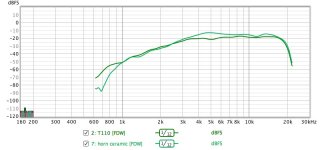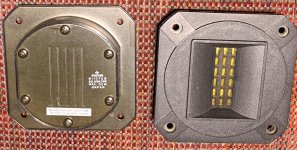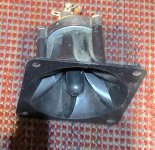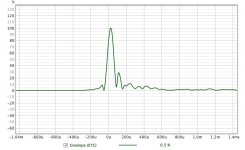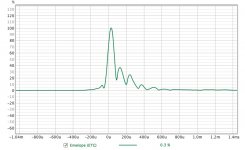Checking a whole bunch of tweeters. Here is a comparison of (1) a ceramic tweeter with a fancy horn that bought for can$3, maybe 50 years ago and (2) a Fostex planar (may have been in a top-end Infinity) with model number E110, looks similar to some at Madisound for us$700.
FR and distortion. Green trace is ceramic, not that you can tell the difference in traces.
Impulse plots look similar too.... believe it or not. But ESL trace better.
Glad if anybody could tell me what is that Foster tweeter. Pictures will be posted later.
B.
FR and distortion. Green trace is ceramic, not that you can tell the difference in traces.
Impulse plots look similar too.... believe it or not. But ESL trace better.
Glad if anybody could tell me what is that Foster tweeter. Pictures will be posted later.
B.
Attachments
Last edited:
First thing I think of when seeing Foster planar tweeters is de Elipson 1303. That was quite brilliant. Should look like this one Ohm Audio bv - The AUDIOSHOP
Art. ELI1303FOSTERBT1
Art. ELI1303FOSTERBT1
Last edited:
I was rushing through a big pile, so kind of rough lab work.
About 11 inches. Not too loud - guessing at 85 dB (but same voltage for all the tweeters)... which would make the distortion measurements pretty impressive with all the crap and abients sounds around.
B.
About 11 inches. Not too loud - guessing at 85 dB (but same voltage for all the tweeters)... which would make the distortion measurements pretty impressive with all the crap and abients sounds around.
B.
The background noise can be an issue at such low levels. You may be measuring mostly that, instead of distortion from the driver.
I tend to listen at lower levels, so testing at high SPL's isn't my default behavior, but when it comes to distortion you are typically better off pushing the levels up some (assuming the driver can take it). For distortion, I often set a reference level of 90-95 dB at 1 meter, then move the microphone closer so I have even better signal to noise performance. Depending on what I'm doing, near is sometimes around a foot. Other times it's almost touching the driver.
Restricting the frequency range of the test can help protect the driver if things look iffy or if you're in a hurry and don't want to run a few tests with increasing levels to make sure distortion isn't getting out of hand.
I tend to listen at lower levels, so testing at high SPL's isn't my default behavior, but when it comes to distortion you are typically better off pushing the levels up some (assuming the driver can take it). For distortion, I often set a reference level of 90-95 dB at 1 meter, then move the microphone closer so I have even better signal to noise performance. Depending on what I'm doing, near is sometimes around a foot. Other times it's almost touching the driver.
Restricting the frequency range of the test can help protect the driver if things look iffy or if you're in a hurry and don't want to run a few tests with increasing levels to make sure distortion isn't getting out of hand.
Considering the value of these tweeters (at least some of them), best not to risk loud inputs and DC from the amp, and etc. While great fun to see how loud it goes, no great help in learning more about them.
While I can't say as the THD was as low as possible with air-conditioning going, it is quite low and it is substantially below other tweeters such a fancy fried egg dome* tested the same way.
Here're pictures of the two tweeters. Please help me identify (and find info about) the Foster tweeter. Also see my other thread about the E120.
Thanks.
B.
* That newish fancy fried egg had rather the very same FR, THD, and impulse profile as a "Philco" tweeter a group of us at Bell Labs chose in 1968 when we bought a large carton of them.
While I can't say as the THD was as low as possible with air-conditioning going, it is quite low and it is substantially below other tweeters such a fancy fried egg dome* tested the same way.
Here're pictures of the two tweeters. Please help me identify (and find info about) the Foster tweeter. Also see my other thread about the E120.
Thanks.
B.
* That newish fancy fried egg had rather the very same FR, THD, and impulse profile as a "Philco" tweeter a group of us at Bell Labs chose in 1968 when we bought a large carton of them.
Attachments
Last edited:
With a 90 dB sensitive tweeter, 1 watt gets you 90 dB at one meter. That's a tolerable drive level for most any driver. Nowhere in my response did I suggest "seeing how loud it goes", using high power, DC, or inappropriate frequencies/levels for any test.
If you think about the levels you are trying to accurately measure, it becomes obvious that a useful amount of signal at the microphone is required. If you're at 85 dB at the microphone with your test signal and you have a 40 dB noise background (average home), you can't accurately measure more than 45 dB below your reference level, which is equivalent to 0.56% distortion.
Of course everything is more complicated than this because noise sources have different spectra, some are intermittent, you could be wrong about your guessed SPL levels, etc., but it doesn't change the basic math of what needs to happen to get a reasonably accurate measurement.
If you think about the levels you are trying to accurately measure, it becomes obvious that a useful amount of signal at the microphone is required. If you're at 85 dB at the microphone with your test signal and you have a 40 dB noise background (average home), you can't accurately measure more than 45 dB below your reference level, which is equivalent to 0.56% distortion.
Of course everything is more complicated than this because noise sources have different spectra, some are intermittent, you could be wrong about your guessed SPL levels, etc., but it doesn't change the basic math of what needs to happen to get a reasonably accurate measurement.
My thoughts are things on the other end of the scale needs consideration too.
Put the microphone at very close distance, maybe 1-2 inches. Then we measure at the lowest volume possible. This would be determining the frequency response at low levels. Would be for matters like how it would play the triangle in an orchestra?
I believe this is where the difference is in performance of tweeters
Oon
Put the microphone at very close distance, maybe 1-2 inches. Then we measure at the lowest volume possible. This would be determining the frequency response at low levels. Would be for matters like how it would play the triangle in an orchestra?
I believe this is where the difference is in performance of tweeters
Oon
That's very interesting. Certainly something like that matters with amps which can have gremlins are very low loudness and those levels must be present when listening (that is, there are always moments of near-silence in music).
However, I have never seen anybody demonstrate what your are suggesting. And I have never seen any difference in frequency response at different levels in all kinds of tests I've ever done.
Evidence?
B.
However, I have never seen anybody demonstrate what your are suggesting. And I have never seen any difference in frequency response at different levels in all kinds of tests I've ever done.
Evidence?
B.
I haven't had a chance to observe this in a measurement yet, I suppose maybe because most of the tweeter I bought is of reasonable quality.
But I do notice that in cheap hifi, one thing is clear, they are unable to reproduce very low level treble well. For example, a triangle in an orchestra or brush on a high hat. It just appears loud when turned up loud or nothing at all when you turn it down soft. And the power level we are looking at is probably -30db from the peak. Therefore I expect the power level to be in the 10mW level or even less. And in compression drivers, maybe only 1mW.
Need to ensure your rest of the signal chain is not the one screwing up the sound.
One day when I have the time i might set up this experiment and try out to see the results...
Oon
But I do notice that in cheap hifi, one thing is clear, they are unable to reproduce very low level treble well. For example, a triangle in an orchestra or brush on a high hat. It just appears loud when turned up loud or nothing at all when you turn it down soft. And the power level we are looking at is probably -30db from the peak. Therefore I expect the power level to be in the 10mW level or even less. And in compression drivers, maybe only 1mW.
Need to ensure your rest of the signal chain is not the one screwing up the sound.
One day when I have the time i might set up this experiment and try out to see the results...
Oon
I suppose Fletcher and Munson might explain that, at least a good portion of it.in cheap hifi, one thing is clear, they are unable to reproduce very low level treble well. For example, a triangle in an orchestra or brush on a high hat. It just appears loud when turned up loud or nothing at all when you turn it down soft.
Don't think it's that one. In a good quality tweeter, I can here distinctly as a low level treble. Very obvious in the cheap mini hifi. Something you would hear at late night listening when you are playing it softly.I suppose Fletcher and Munson might explain that, at least a good portion of it.
If anything I believe it is the presence of crossover distortion of sorts. Probably mechanical coupling between the various part, maybe voice coil and dome. Or maybe static resistance in the spider or some form of mechanical hysteria. I don't know. But I suspect there are a different mechanism at low levels. Most of the time people are looking at at 1W graph, but I am interested in the 10mW graph. Or even the 1mW graph. I think the power level is so low I might need to drive it using a headphone amp....
Oon
I suppose Fletcher and Munson might explain that, at least a good portion of it.
+1
Tricky to measure speaker distortion when playing softly because ambient crap increases making distortion look falsely larger. Anybody with a measurement fix?
B.
I did something like that once... I put the microphone a few cm from the driver....+1
Tricky to measure speaker distortion when playing softly because ambient crap increases making distortion look falsely larger. Anybody with a measurement fix?
B.
Oon
To measure very low SPLs, an isolating enclosure should improve things at higher frequencies. For a tweeter, something like a 1 foot cube made of 1/2 inch MDF that's lined inside with 2 inch or greater acoustical foam should work (absorption graphs are usually available to confirm the foam's performance at the frequencies of interest). With the microphone mounted inside, you can then use a removable side to mount the speaker to, use a small port to press the speaker/baffle against, or just put the tweeter inside with the microphone and remount the side used for access. If your microphone is large, obviously the box may need to be a bit larger also.
As you try to measure lower in frequency, you'll need larger/more massive walls and thicker foam. At tweeter frequencies, things should be much easier though.
A couple commercial examples of portable chambers:
Small anechoic chamber | IAC Acoustics A/S
Portable Anechoic Chambers - Eckel USA Eckel USA
And a paper:
Low-cost and easily implemented anechoic acoustic chambers
As you try to measure lower in frequency, you'll need larger/more massive walls and thicker foam. At tweeter frequencies, things should be much easier though.
A couple commercial examples of portable chambers:
Small anechoic chamber | IAC Acoustics A/S
Portable Anechoic Chambers - Eckel USA Eckel USA
And a paper:
Low-cost and easily implemented anechoic acoustic chambers
Thanks for suggestions.
But the issue is as much one of isolation from ambient garbage as echo.
Also, real-time analysis plots can illuminate low-loudness distortion.
But the issue is as much one of isolation from ambient garbage as echo.
Also, real-time analysis plots can illuminate low-loudness distortion.
So you think ambient noise at 40 or 50 dB and greater than 2 kHz is going to get through a sealed box of half inch MDF and multiple inches of foam that's 100% absorbing at those frequencies?
And you think all these people making small chambers are just worried about internal echoes?
And you chose to ignore the parts of my post where I specifically said that lower frequencies require more massive walls?
And you ignored the part in the attached paper that says: "The anechoic chamber must be isolated from external noises that might disturb the measurements to be performed in the chamber."
It seems you're being argumentative, so I'll drop out of this thread.
And you think all these people making small chambers are just worried about internal echoes?
And you chose to ignore the parts of my post where I specifically said that lower frequencies require more massive walls?
And you ignored the part in the attached paper that says: "The anechoic chamber must be isolated from external noises that might disturb the measurements to be performed in the chamber."
It seems you're being argumentative, so I'll drop out of this thread.
Here are the impulse plots for the T110 (to the right in the left photo on post #6) and the ceramic horn tweeter. Not much false action beyond half a milli-second for either. The $3, 50 year old tweeter is looking pretty good.
Pity those piezo-electric tweeters get so little "respect". Dayton-Wright had one in their later ESLs... and everybody scoffed at him for doing so.
I'm always saddened to see so many argumentative posts instead of folks posting their own data.
Pity those piezo-electric tweeters get so little "respect". Dayton-Wright had one in their later ESLs... and everybody scoffed at him for doing so.
I'm always saddened to see so many argumentative posts instead of folks posting their own data.
Attachments
Last edited:
IIRC, the original Motorola piezos were/are a cut above the later ubiquitous ones. Part of the reason they get such a bad rep? Plus not crossing them over correctly. Frugal-phile | Piezo Tweeter Crossovers | J RischPity those piezo-electric tweeters get so little "respect". Dayton-Wright had one in their later ESLs... and everybody scoffed at him for doing so.
I agree, the original Motorola piezos were definitely higher fidelity than recent clones. In particular they had essentially a complete lack of mid-band resonance which are easy to hear as "birdies" or whistle tones while slowly sweeping thru the bandwidth with an audio oscillator.
@bentoronto,
Looks like you are showing the ETC(Energy Time Curve), perhaps with a mS or so of smoothing?
The impulse response will have both positive and negative going peaks due to the tweeter's HP nature.
@bentoronto,
Looks like you are showing the ETC(Energy Time Curve), perhaps with a mS or so of smoothing?
The impulse response will have both positive and negative going peaks due to the tweeter's HP nature.
- Home
- Loudspeakers
- Planars & Exotics
- Tweeter shootout, ceramic versus fancy
